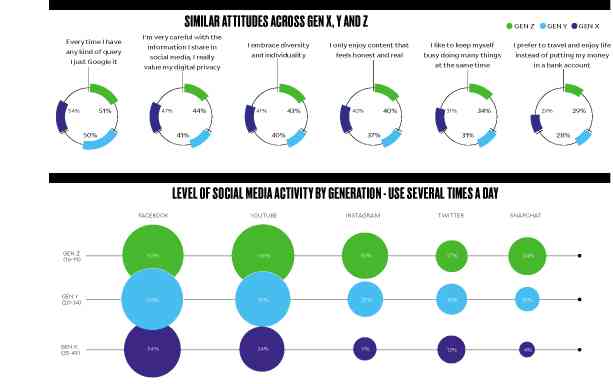A shoutout to all brand marketers: The “centennials,” or Gen Z, are growing up, and they are proving to be a challenging audience.
Results of a study by international research firm Kantar Millward Brown called “AdReaction: Engaging Gen X, Y and Z” recently revealed that compared to baby busters (Gen X) and millennials (Gen Y), the centennials—those born between 1997-2011—are a “particularly tricky” audience to engage, “because they are highly discriminating and more averse to advertising in general” compared to the two older generations.
The global study surveyed more than 23,000 16- to 49-year-old consumers across 39 countries, conducted qualitative research among Gen Z in the United States, Germany and China, and tested 31 ads across TV and digital platforms in 10 countries.
The research is Kantar Millward Brown’s first attempt “to reveal Gen Z’s behaviors, attitudes and responses to advertising to help marketers.”
Based on the study’s results, it appears that to impress Gen Z (characterized as “digital natives” and a “mobile-first generation” who make up around two billion of the world’s population), brands are advised to follow these tips: be creative and social; keep it short and sweet; and respect their online space.
Despite being, as mentioned, a mobile-first generation, Gen Z, like the two older groups, still prefer traditional advertising over digital.
“Digital ads may be a part of everyday life, but they’re not something people welcome as much as print, outdoor, TV and cinema advertising,” the report reads. On the flip side, Gen Z is the most accepting of new forms of content, such as native advertising or sponsored lenses and filters.
However, the study found that centennials are also the least receptive toward ads of the three age groups, mainly because they feel “overwhelmed” by the sheer volume they see every day.
This means that across all channels, “Gen Z audiences constantly—and consciously—making decisions about whether to avoid or engage with the advertising they see.” In the digital realm, Gen Z reacts more positively to ads which they can skip or close, as well as those which offer rewards; while pop-ups are a definite no-no.
Therein lies the challenge for brand marketers: how to create ads that will fully engage Gen Z audiences so that they don’t just press the “skip” button. The study identified four key aspects when it comes to ads’ creative development: music, humor, design and celebrity.
Comparing the three generations’ attitudes toward their personal lives, the study reveals that, globally, centennials place higher value on having access to music via digital platforms, and that they “are more likely than other generations to demand that the content they consume is matched by ‘good’ music and humor they identify with.”
The study also found that Gen Z audiences appreciate great design better than their older counterparts, as well as the presence of celebrities, both mainstream and internet (think bloggers, vloggers, or those known for being “social media-famous”).
However, the picture is slightly different here in the Philippines.
Locally, it is Gen Y that finds the use of music and celebrities most appealing, with 62 percent agreeing that music makes them more receptive and 27 percent citing celebrities (compared to 47 percent and 23 percent, respectively, for Gen Z). The characteristic that makes Gen Z in the Philippines most positive towards ads is the use of humor, at 53 percent, although it is still far lower than the scores for Gen X (65 percent) and Gen Y (67 percent).
Other key findings for the Philippines:
Despite being the generation that grew up with mobile technology, Gen Z’s daily usage is lower than that of older generations, with only 66 percent spending more than an hour a day on their mobile device, compared to 81 percent of Gen Y and 84 percent of Gen X.
However, TV, radio and print consumption are also all lower for Gen Z, with just 49 percent watching an hour or more of TV each day compared to 74 percent for Gen Y and 86 percent for Gen X.
This means brands need to work hard to capture the attention of Gen Z when they are consuming media—either traditional or digital—or risk being missed altogether.
Filipinos of all generations are happy to watch longer video formats. Globally, all generations prefer short videos; however, here, all favor video ads of up to 20 seconds.
Gen Z audiences are starting to use ad blocking software, with 29 percent using it on desktop and 17 percent using it on mobile.
With their skepticism towards advertising, it’s harder to engage Gen Z with branded content compared to Gen X and Y. Although tutorials and expert reviews are popular across all generations, scores remain the lowest amongst Gen Z. To drive the success of branded content, marketers will need to ignite Gen Z’s love for the brand.
“No generation is a monolith and Gen Z is no exception. Their upbringing, expectations and access to technology, however, has created a range of attitudes and behaviors that will challenge marketers. Only when brands take all this into consideration will they be successful in engaging this increasingly critical and fast-emerging group of consumers,” says Duncan Southgate, Kantar Millward Brown global brand director for
Media and Digital.
